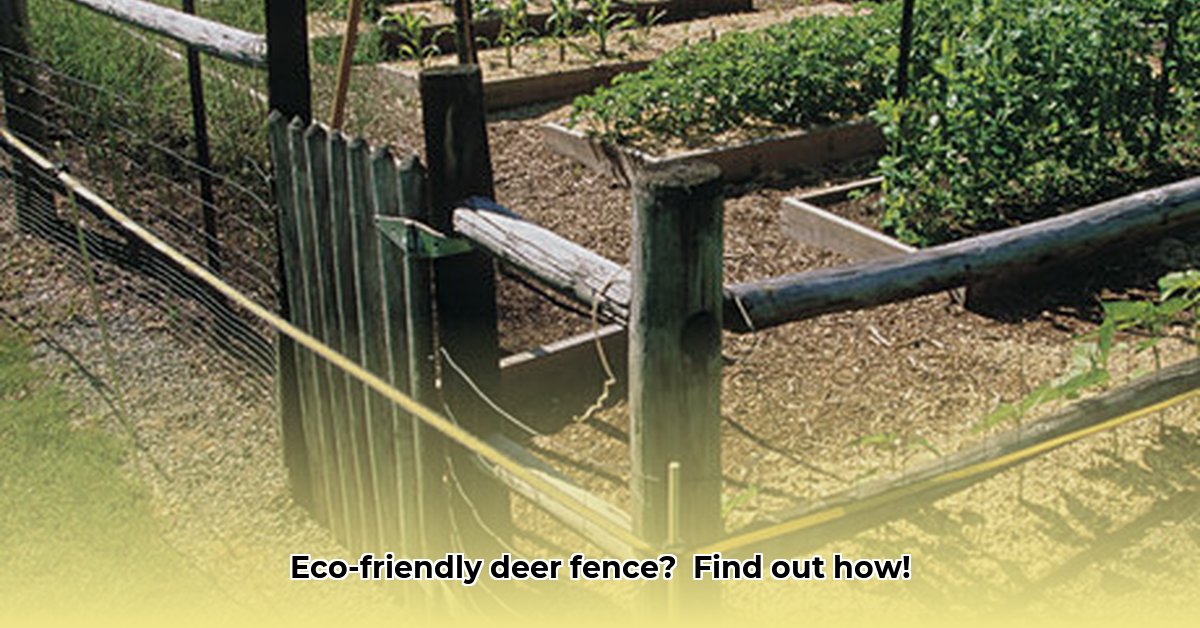
Choosing the Right Deer Fence: More Than Just Height
Protecting crops from deer requires more than just a tall fence. While height is crucial, the material significantly impacts the fence's longevity and environmental footprint. A durable fence minimizes waste and resource consumption in the long run. Tractor Supply offers various options, including Allfenz and Tenax brands, each with unique characteristics. But how do you choose? Choosing a fence made from recycled materials or sustainable sources significantly reduces its environmental impact. Consider the entire life cycle – from manufacturing to disposal. A recycled plastic fence may be preferable to one made from virgin materials. Crucially, proper installation is essential; a poorly installed fence is wasteful and ineffective, regardless of material. This is especially important given that the wrong materials or improper installation could harm wildlife. Do you have a plan to minimize disruption to wildlife corridors? For more information on durable fencing options, check out Tractor Supply options.
The Environmental Impact: A Balancing Act
Is deer fencing truly sustainable? It's a complex issue. While fencing protects crops without harmful chemicals, it can disrupt wildlife movement and potentially impact local ecosystems. Deer aren't the only animals affected; smaller creatures may find their travel routes blocked. Ongoing research explores the broader effects on biodiversity. "The impact of fencing on biodiversity is heavily dependent on factors such as fence location, design, and the surrounding habitat," says Dr. Emily Carter, wildlife biologist at the University of California, Davis.
However, thoughtful planning can mitigate negative impacts. Leaving gaps or using specific fencing types that allow for some animal passage can help. The key is a balanced approach that weighs the benefits of crop protection against potential environmental consequences. What strategies can you implement to minimize the impact on local wildlife?
Going Beyond the Fence: A Holistic Approach
Sustainable farming is about creating a balanced ecosystem. Integrate pest management (IPM) strategies. IPM focuses on prevention, not just reaction. This might involve using deer repellents (effectiveness varies), habitat modification to make fields less appealing to deer, or choosing deer-resistant crop varieties. A multi-pronged approach is often more effective and environmentally friendly than relying solely on fencing. How can you integrate your deer fencing strategy with a broader IPM plan?
Tractor Supply Options: Allfenz and Tenax – A Closer Look
Tractor Supply offers Allfenz and Tenax deer fencing. While specific endorsements require knowledge of their manufacturing processes and materials, we can discuss general features. Both brands are designed to deter deer, but their durability and ease of installation vary. Before purchasing, check for certifications and information on their environmental impact. Ask Tractor Supply staff about materials, manufacturing processes, and recycling programs. What factors are most important to you when choosing between Allfenz and Tenax or other brands?
A Step-by-Step Guide to Sustainable Deer Management
Here’s a sustainable deer management plan:
- Assessment: Evaluate the deer problem and area needing protection.
- Research: Explore fencing materials, heights, and installation methods. Compare prices, lifespan, and environmental impact. Consider alternatives.
- Sustainable Choice: Prioritize recycled or sustainably sourced materials. Consider the product's entire life cycle.
- Careful Installation: Install correctly for maximum effectiveness and minimal environmental disruption.
- Monitoring and Adjustment: Regularly monitor the fence's effectiveness and impact on wildlife. Adapt as needed.
Weighing the Pros and Cons: Sustainable Deer Fencing
| Feature | Pros | Cons |
|---|---|---|
| Effectiveness | Significantly reduces crop losses. | Effectiveness depends on installation and material selection. |
| Environmental Impact | Reduces pesticide use. | Can disrupt wildlife movement; material sourcing is crucial. |
| Cost | Varies depending on materials, size, and installation. | Significant upfront investment may be needed. |
| Longevity | Durable materials minimize frequent replacements. | Materials degrade over time; repairs or replacement is likely. |
Deer fencing is one tool. Combine it with other strategies for a holistic approach. New, more wildlife-friendly designs are in development, so stay informed and adapt. Have you considered the long-term cost-effectiveness of different fencing options?
How to Minimize Environmental Impact of Deer Fencing in Sustainable Agriculture
Key Takeaways:
- A holistic approach to deer management is essential.
- Sustainable practices prioritize eco-friendly materials and minimal wildlife disruption.
- Careful planning and material selection reduce the fencing's environmental footprint.
- Long-term cost-effectiveness and biodiversity impact must be considered.
- Collaboration among farmers is crucial.
Choosing the Right Deer Fence: Balancing Protection and Sustainability
High-tensile wire fences, using durable, potentially recycled materials, offer longevity. Allfenz and Tenax from Tractor Supply are known for strength. Consider integrating the fence into the landscape; strategically incorporating native vegetation blends the fence into its surroundings. How can you minimize the visual impact of your fence while maintaining its effectiveness?
Installation Best Practices for Minimal Disturbance
- Plan Your Fence Line: Avoid sensitive habitats and minimize the fence's footprint.
- Minimize Soil Disturbance: Use minimal excavation.
- Wildlife Corridors: Incorporate wildlife passages.
- Native Plants: Plant native vegetation to restore habitat.
Beyond the Fence: A Multi-Pronged Approach
Use organic deer repellents and ultrasonic devices (effectiveness varies). Monitor and adapt your strategy. "A successful deer management program requires consistent monitoring and adjustment to ensure effectiveness and minimize environmental impact," notes Dr. Mark Johnson, Agricultural Extension Specialist, Purdue University.
Long-Term Sustainability and Economic Considerations
Consider the long-term costs. A durable fence might be more economical than frequent replacements. Remember that crop damage from uncontrolled deer also impacts profitability. Maintaining your fence and considering material recycling contributes to a circular economy.
Looking Ahead: Innovation in Sustainable Deer Fencing
Research into sustainable materials like biodegradable plastics and composite materials continues. Stay informed about advancements. What emerging technologies in sustainable deer fencing are you most excited about?